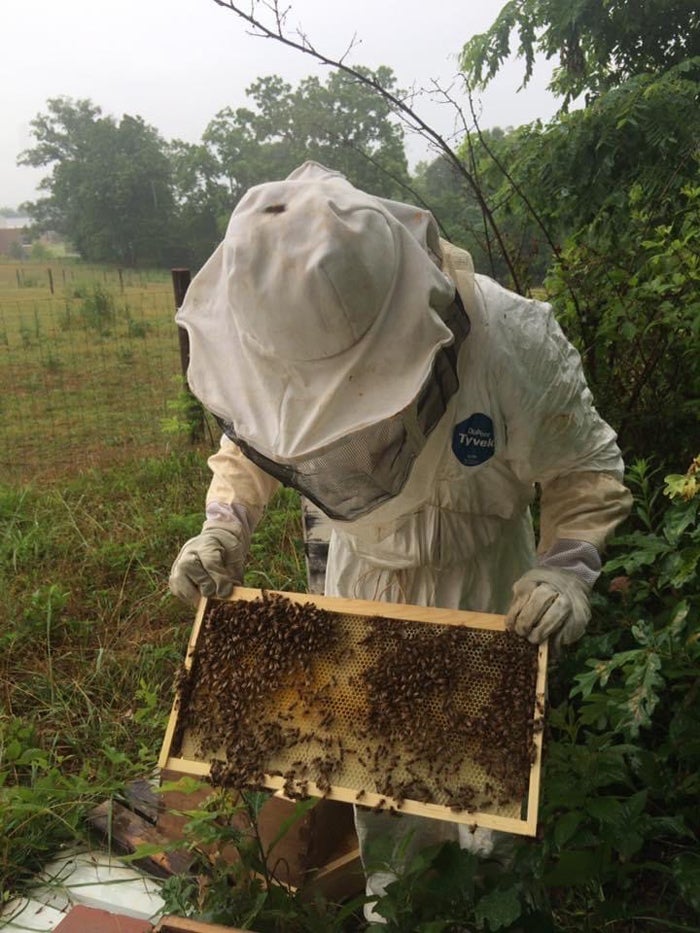Cody Craddock: Beekeeping a hobby you can enjoy at home
Published 12:00 am Sunday, October 31, 2021

- Proper equipment is needed if you want to get into beekeeping as a hobby. Submitted photo
Honeybees are amazing insects that are beneficial to agricultural crops. Some scientists estimate that one out of every three bites of food we eat wouldn’t be possible without honeybees. This is because while a bee collects pollen it visits thousands of flowers and in the process, it may unknowingly brush pollen against the reproductive parts of a flower, which in turn produces a fruit or seed.
This service that honeybees provide unknowingly helps pollinate $15 billion worth of crops annually. Without them our food systems would probably look vastly different since they’d be reliant on just native pollinators. With some proper training you can keep bees in your own backyard and have a hobby that will pay off!
First, you’ll want to get some training for the hobby and speak with beekeepers. There is an inherent sting risk so be mindful of allergies to bee stings you or a family member may have. Find a local beekeepers association for your county, visit a couple meetings and consider joining as a member.
If you’re in Rowan County, our beekeeping association meets every second Monday from 7 p.m.-9 p.m. The next meeting is Nov. 8. Lots of these associations offer beekeeping schools, typically in the winter, to train new beekeepers and prepare them for an upcoming season.
Another option for training is the BEES Academy Beginner Courses. These courses are offered through the North Carolina State University Apiculture Program and will provide the basic knowledge needed to keep bees.
Once you’re comfortable in your abilities after trainings, you’ll want to purchase the hive, equipment and bees. A standard hive costs anywhere from $125 to $200. Basic equipment costs another $100 or so, and bees run about $150 for a package.
You’ll also need supplies like smoker fuel, varroa treatments and certain tools. There are also options where you can purchase a “beginner’s hive” with everything you need and sometimes for a discounted price. After you’ve got your hive, you’ll want to find a location to set it up. Put some thought in where you place your bees since you’ll be working with them often. Be sure that the location has morning sun because this prompts the bees to get an early start to their day. To maximize this effect, you’ll want to face your hives towards the east.
You’ll also want to make sure your bees have access to water, entrances facing opposite to foot traffic and afternoon shade. Once you’ve found a location, set up your hive and install your bees in April.
One very important aspect of honeybee management is treatment for the varroa mite, which is native to Asia and first detected in Indonesia. The Asian honeybee (Apis cerana) has developed defense mechanisms that helps their colonies fend off the mites. The Asian honeybee is much more “hygienic” in that they keep their hive cleaner than other honeybees.
The Western honeybee (Apis melliferia) has not developed this defense to varroa and is much more susceptible to damages from the mites. Varroa mites were first detected in the U.S. in 1987 and were first detected in North Carolina in 1990. Since then, beekeepers and researchers have been working vigorously to find a treatment for them.
There are a variety of treatments that are proven to be effective for treating varroa mites and are readily available. Special care needs to be taken when administering these treatments since they can contaminate honey that may be intended for human consumption. Be sure to follow the label for the product you’re using.
Beekeepers will want to do a pre-treatment and post-treatment check for mites to evaluate the efficacy of the medications. Varroa can develop resistance to miticides much like bacteria develop resistance to anti-biotics. A healthy rotation of treatment strategies can help fight varroa and the inherent resistance surviving populations may have. Experienced beekeepers will be your best friend when learning how to treat for varroa mites so attend your local meeting as much as you can!
At this point you’re probably wondering if all this work is worth it and let me tell you — there’s nothing more satisfying than seeing the first jar of honey from your honeybees being filled to the brim. You’re likely not to be able to harvest much honey in the first year but by mid to late summer the following season, you should see significant honey stores from your bees.
Harvesting honey is a pretty straightforward process that involved uncapping the honeycombs and extracting the honey from the wells. Once you see the viscous, golden flow of honey come out and into a jar you’ll feel well-deserving of a pat on the back. Not only did your bees create a tasty treat to enjoy but they also provided a noble service to gardens, farms, and flowering plants all around you and there’s some pride to be taken in that.
Cody Craddock is agriculture and natural resource agent for N.C. Cooperative Extension Center in Rowan County Center.




